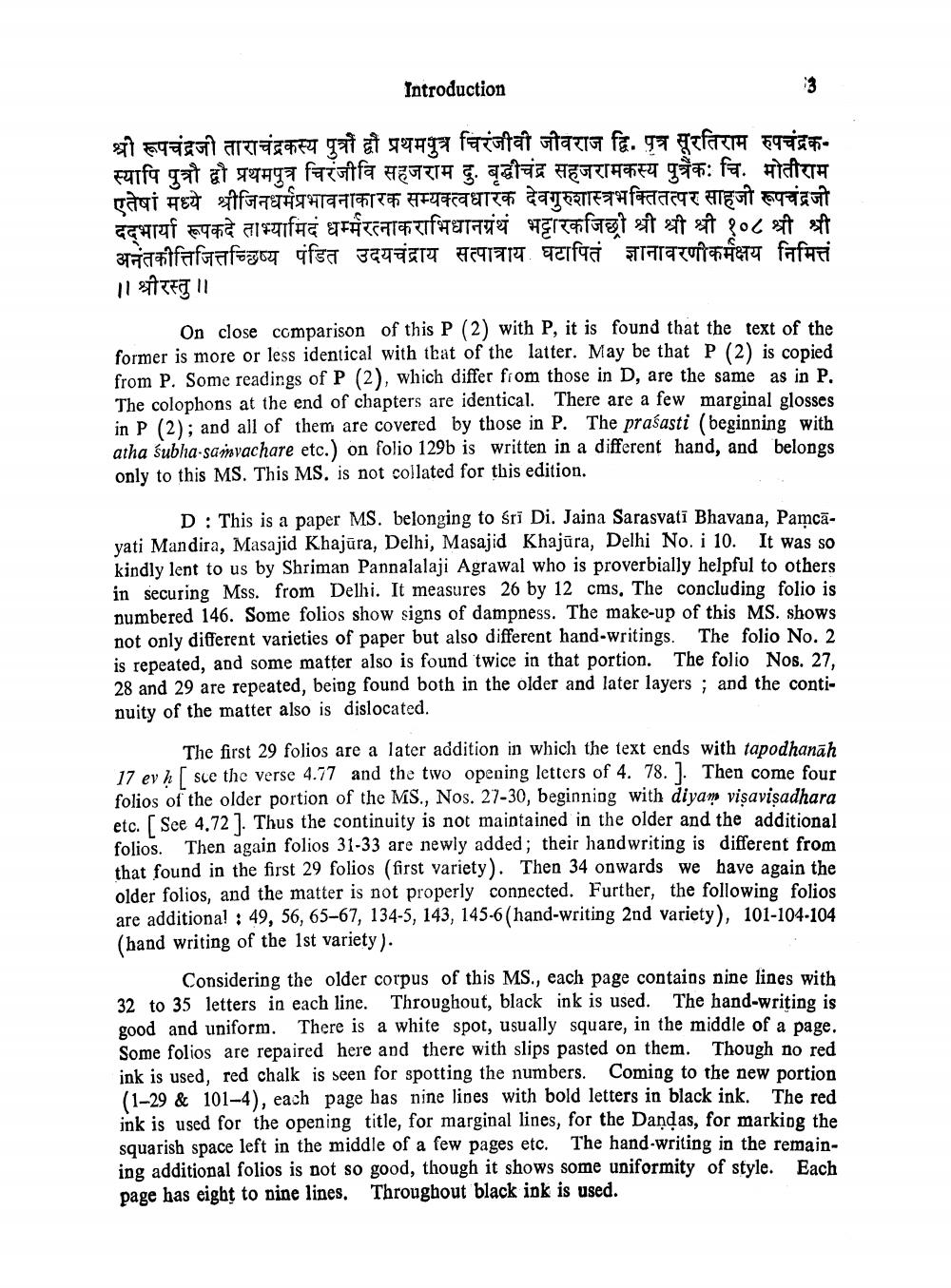________________
Introduction
13
श्री रूपचंद्रजी ताराचंद्रकस्य पुत्रों द्वो प्रथमपुत्र चिरंजीवी जीवराज द्वि. पुत्र सूरतिराम रुपचंद्रकat स्यापि पुत्रौ द्वौ प्रथमपुत्र चिरंजीवि सहजराम दु. बृद्धीचंद्र सहजरामकस्य पुत्रैकः चि. मोतीराम एतेषां मध्ये श्रीजिनधर्मप्रभावना कारक सम्यक्त्वधारक देवगुरुशास्त्रभक्तितत्पर साहजी रूपचंद्रजी दद्भार्या रूपकदे ताभ्यामिदं धर्म्मरत्नाकराभिधानग्रंथ भट्टारकजिद्दी श्री श्री श्री १०८ श्री श्री अनंतकीत्तिजित्तच्छिष्य पंडित उदयचंद्राय सत्पात्राय घटापितं ज्ञानावरणीकर्मक्षय निमित्तं ॥ श्रीरस्तु ॥
On close comparison of this P (2) with P, it is found that the text of the former is more or less identical with that of the latter. May be that P (2) is copied from P. Some readings of P (2), which differ from those in D, are the same as in P. The colophons at the end of chapters are identical. There are a few marginal glosses. in P (2); and all of them are covered by those in P. The prasasti (beginning with atha Subha-samachare etc.) on folio 129b is written in a different hand, and belongs only to this MS. This MS. is not collated for this edition.
D: This is a paper MS. belonging to śri Di. Jaina Sarasvati Bhavana, Pamelyati Mandira, Masajid Khajura, Delhi, Masajid Khajara, Delhi No. i 10. It was so kindly lent to us by Shriman Pannalalaji Agrawal who is proverbially helpful to others. in securing Mss. from Delhi. It measures 26 by 12 cms. The concluding folio is numbered 146. Some folios show signs of dampness. The make-up of this MS. shows not only different varieties of paper but also different hand-writings. The folio No. 2 is repeated, and some matter also is found twice in that portion. The folio Nos. 27, 28 and 29 are repeated, being found both in the older and later layers; and the continuity of the matter also is dislocated.
The first 29 folios are a later addition in which the text ends with tapodhanah 17 ev [see the verse 4.77 and the two opening letters of 4. 78. ]. Then come four folios of the older portion of the MS., Nos. 27-30, beginning with diyan visavisadhara etc. [See 4.72]. Thus the continuity is not maintained in the older and the additional folios. Then again folios 31-33 are newly added; their handwriting is different from that found in the first 29 folios (first variety). Then 34 onwards we have again the older folios, and the matter is not properly connected. Further, the following folios are additional 49, 56, 65-67, 134-5, 143, 145-6(hand-writing 2nd variety), 101-104-104 (hand writing of the 1st variety).
Considering the older corpus of this MS., each page contains nine lines with. 32 to 35 letters in each line. Throughout, black ink is used. The hand-writing is good and uniform. There is a white spot, usually square, in the middle of a page. Some folios are repaired here and there with slips pasted on them. Though no red. ink is used, red chalk is seen for spotting the numbers. Coming to the new portion (1-29 & 101-4), each page has nine lines with bold letters in black ink. The red ink is used for the opening title, for marginal lines, for the Dandas, for marking the squarish space left in the middle of a few pages etc. The hand-writing in the remaining additional folios is not so good, though it shows some uniformity of style. Each page has eight to nine lines. Throughout black ink is used.




